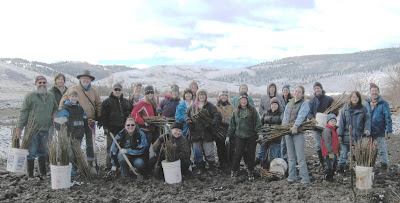
Story & photo by Brian Kelly, Restoration Coordinator
On a recent Saturday morning, HCPC volunteers worked on-the-ground to make the world a better place for native fish and wildlife. Well, to be more precise about it, they worked in the mud to make things better. Twenty-four volunteers planted four thousand native willow cuttings along the banks of Ladd Creek. The creek was recently re-constructed from a straightened ditch into a meandering stream channel. This configuration will provide improved habitat for fish and wildlife. Coyote willows and Booth willows were planted along the new stream bank. The willows will help stabilize the bank, shade the water, and will provide important habitat for birds and other animals.
Ladd Creek is located in the Ladd Marsh Wildlife Area at the southwest end of the Grande Ronde Valley. At just over six thousand acres, Ladd Marsh is the largest remaining wetland in northeast Oregon. Unique and diverse plants grow in the area and it is a haven for wildlife. Ladd Marsh Wildlife Area is home for fish, frogs, salamanders, deer, elk and pronghorn antelope, and many different kinds of birds, insects and other animals.
A dusting of new snow and a plethora of mud greeted us as we arrived at the creek to begin planting. Winston Morton of Oregon Department of Fish & Wildlife provided instructions and our valiant volunteers slogged through the mud with impressive enthusiasm. Shovels opened holes for the willow cuttings and the planters placed the willows in their new homes by the creek. Sandhill cranes serenaded us as we went about our planting. By noon, four thousand new willows had been planted along the creek.
I know that when I drive by Ladd Marsh in the future I will looking to see the young willows grow up into a new ecosystem.
Thanks to Oregon Department of Fish & Wildlife and Friends of Ladd Marsh.

No comments:
Post a Comment